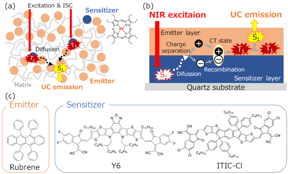Home > Press > Efficient photon upconversion at an organic semiconductor interface
 |
| Fig. 1 (a) Schematic illustrations of the conventional UC mechanism in films, and chemical structure of conventional sensitizer. (b) Schematic illustrations of the novel UC mechanism at the organic semiconductor interface. (c) Chemical structures of sensitizer and emitter of the novel UC systems.
CREDIT NINS/IMS |
Abstract:
Photon upconversion (UC) is a process in which a material increases the energy of incident photons, resulting in the emission of photons with higher energies. The potential applications of UC include the recovery of wasted low-energy photons in photovoltaics and photocatalysis. In addition, near-infrared (NIR) to-visible UC, offering the advantage of high penetration in living tissues, is desired for biosensing, optogenetics, and photodynamic therapy. The conventional UC system relies on a triplet formation from an absorbed photon by intersystem crossing (ISC), which is typically facilitated by heavy-atom effect in a sensitizer molecule (Fig. 1a). The two triplet excitons form high energy one singlet by an annihilation process. Finally, the UC emission occurs from an emitter molecule. However, the conventional solid-state UC is still inefficient, exhibiting a highest external quantum efficiency (EQE) of less than 0.1%, which remains the greatest challenge inhibiting its real-life applications.
Efficient photon upconversion at an organic semiconductor interface
Tokyo, Japan | Posted on November 19th, 2021
Group of Assistant Professor Seiichiro Izawa and Professor Masahiro Hiramoto at Institute for Molecular Science in Japan report that novel UC systems with heterojunctions of bilayer films of organic semiconductors (Fig. 1b). The mechanism of the first step involved in the novel UC relies on the charge separation at the sensitizer/emitter interface, thereby converting the photoexcited sensitizer singlet to free charges. This process is the same as the photoconversion at the electron donor/acceptor interface in organic photovoltaics. Subsequently, the free charges recombine to form the triplet at the interface. The UC emission is observable after the triplet-triplet annihilation. The sensitizer/emitter molecules used in the novel UC system (Fig. 1c) do not contain heavy atoms because the mechanism does not rely on ISC. According to the proposed mechanism, the entire pure sensitizer layer can absorb the incident light and contribute to the UC process. As a result, the solid-state UC system is achieved with the EQE of two orders of magnitude higher than those of the conventional systems, with an irradiation intensity about 100 mW/cm2, which is similar with standard solar fluence. The efficient UC enabled a demonstration of bright yellow emission on a flexible thin film by a NIR light-emitting diode excitation (Fig. 2). The novel UC system does not need strong laser excitation and the expensive platinum-group metals, rare-earth metals, or toxic elements. The finding leads to important applications of UC in flexible solar cells, bioimaging, and optogenetics.
####
For more information, please click here
Contacts:
Hayao KIMURA
National Institutes of Natural Sciences
Office: 81-354-251-890
Expert Contact
Seiichiro Izawa
Institute for Molecular Science
Office: 81-564-59-5537
Copyright © National Institutes of Natural Sciences
If you have a comment, please Contact us.
Issuers of news releases, not 7th Wave, Inc. or Nanotechnology Now, are solely responsible for the accuracy of the content.
News and information
![]()
Scientists develop promising vaccine method against recurrent UTI November 19th, 2021
![]()
How ultracold, superdense atoms become invisible: A new study confirms that as atoms are chilled and squeezed to extremes, their ability to scatter light is suppressed November 19th, 2021
![]()
New microscopy method offers 3D tracking of 100 single molecules at once November 19th, 2021
Organic Electronics
![]()
Molecular coating enhances organic solar cells June 11th, 2021
![]()
Going Organic: uOttawa team realizing the limitless possibilities of wearable electronics January 28th, 2021
![]()
Engineers find antioxidants improve nanoscale visualization of polymers January 8th, 2021
Possible Futures
![]()
Developing high-performance MXene electrodes for next-generation powerful battery November 19th, 2021
![]()
New microscopy method offers 3D tracking of 100 single molecules at once November 19th, 2021
Chip Technology
![]()
Visualizing temperature transport: An unexpected technique for nanoscale characterization November 19th, 2021
![]()
Quantifying spin for future spintronics: Spin-momentum locking induced anisotropic magnetoresistance in monolayer WTe2 November 5th, 2021
![]()
A new dimension in magnetism and superconductivity launched November 5th, 2021
![]()
Nanoscale lattices flow from 3D printer: Rice University engineers create nanostructures of glass and crystal for electronics, photonics October 15th, 2021
Optical computing/Photonic computing
![]()
Quantum Collaboration: Two UCSB scientists receive award to partner with Ciscos new Quantum Research Team November 3rd, 2021
![]()
Photon-pair source with pump rejection filter fabricated on single CMOS chip: New integrated source provides critical component for chip-based quantum photonic systems October 15th, 2021
![]()
Nanoscale lattices flow from 3D printer: Rice University engineers create nanostructures of glass and crystal for electronics, photonics October 15th, 2021
Discoveries
![]()
Developing high-performance MXene electrodes for next-generation powerful battery November 19th, 2021
![]()
New microscopy method offers 3D tracking of 100 single molecules at once November 19th, 2021
Announcements
![]()
New microscopy method offers 3D tracking of 100 single molecules at once November 19th, 2021
![]()
Visualizing temperature transport: An unexpected technique for nanoscale characterization November 19th, 2021
Interviews/Book Reviews/Essays/Reports/Podcasts/Journals/White papers/Posters
![]()
Scientists develop promising vaccine method against recurrent UTI November 19th, 2021
![]()
How ultracold, superdense atoms become invisible: A new study confirms that as atoms are chilled and squeezed to extremes, their ability to scatter light is suppressed November 19th, 2021
![]()
Energizer atoms: JILA researchers find new way to keep atoms excited November 19th, 2021
![]()
Developing high-performance MXene electrodes for next-generation powerful battery November 19th, 2021
Photonics/Optics/Lasers
![]()
Visualizing temperature transport: An unexpected technique for nanoscale characterization November 19th, 2021
![]()
Photon-pair source with pump rejection filter fabricated on single CMOS chip: New integrated source provides critical component for chip-based quantum photonic systems October 15th, 2021
![]()
Nanoscale lattices flow from 3D printer: Rice University engineers create nanostructures of glass and crystal for electronics, photonics October 15th, 2021










